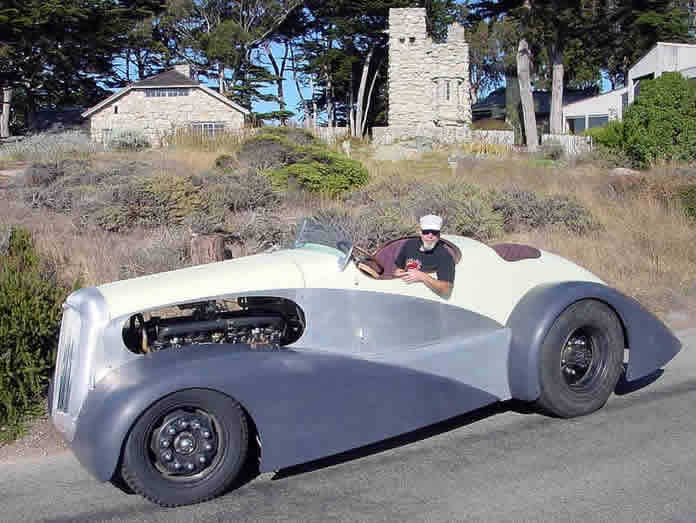
It's that time again, time for the sun to hang around a little longer and time for a car show. The California Mille begins with an all day party and car display in front of the Fairmont Hotel atop San Francisco's Nob Hill, their "Kick Off" so to speak.
Well, not to be out done, we thought we might as well have a kick-off of our own. The day before the party SCDC left the city and headed for the hills.
What's a great car to tackle both tight city streets and mountain switchbacks? Parallel parking and apex clipping? The Mini Cooper S. With it's wide stance, taut suspension and responsive drive-train, the Mini really is an underrated sports car. I spent the day with my lovely co-driver in a 2006 "S", while friends followed in an '03. We began by slicing through Ocean Beach and over the Golden Gate. Boats of every size criss-crossed the bay below us, taking advantage of the ideal spring weather. We inched through Tamalpais Valley (traffic) and on toward the coast. Once we crested Coyote Ridge and entered Muir Woods, the traffic cleared for just long enough to see what the Mini was all about. Sometimes it's the little things; a small, thick leather steering wheel, well placed pedals and a decent shifter make this car very inviting. Add to that great visibility, nice seats and a flexible, 168 horse power supercharged 4 cylinder and let's motor! This section of HWY1 is windy and smooth, as it steadily descends, carved into the earth and perched above the ocean far below. No room for heroics here- especially with Saturday traffic on hand. Instead we saved that for the road to come.
Once past Stinson Beach we turned on to our secret road. Not to say this is an impossible route to copy, but I'd like to keep it challenging to find. Rough and barely wide enough for a passing car, there were no lines to divide the oncoming lane- this old road was just what the doctor ordered. While the Mini does boast some surprisingly stiff sport suspension, it handled every bump, crack or dip just as you would expect a relative of the BMW 3 series to perform. We quickened the pace and began to get a feel for the tight and twisty road. I kept it in second gear most of the time, letting the supercharger whine, going to first only for the tightest of hair pins. The brakes were nearly fade resistant, fortunately, as I relied on them heavily after every short straight to get the stout little hatchback around the next bend (mostly hair pins). It got old seeing that dark gray Mini in my rear view mirror, and I decided to push my tires to their limits. I exercised third gear now and pressed the brakes to where I thought they would fade- still nothing! As my co-pilot and I glanced for the next turn out of the side windows, the Mini squealed it's front tires as we chirped and accelerated out of every corner. Redwood trees served as apexes and I was finally able escape the shadow behind me, if only temporarily. Around the next sweeping blind turn an oncoming Prius lazily wafted into our lane just slightly...enough to cause me to react with a sharp stab of the brakes and a quick tug on the leather steering wheel. The Mini never flinched, disaster averted. I think the Prius owner has probably just gotten their breath back by now, but wouldn't you know it; my Mini cohort has taken advantage of my "avoidance maneuver" and attached himself to my tail once again. One step forward...
As we emerged from the dark Redwood forest, we were presented with a perfect stretch of sunny pavement before us. The road lined the top of a ridge with grassy meadows and wildflowers with the great Bolinas Lagoon, and the Pacific Ocean sprawled out down below us. (I realize now...I was in a damn Mini commercial! Where was the helicopter camera?) What a road! Well paved, nice elevation changes and views galore. We stopped a moment to take it in before we headed on toward Mt Tamalpais. We continued on up toward the top of the mountain. The road remained narrow for the rest of the ascent, and the Mini still proved to be the perfect little warrior...sharing the road with cyclists and weekend drivers alike, but always urging to go little quicker.
We walked back to the parked Mini's to reflect on the drive, apparent sunburns and dinner options. There isn't a lot to compare between the '03 and '06 Cooper "S". Aside from the headlights and slight interior changes, they are essentially the same. As far as the driving experience goes- again it's too close to call. I know everyone says these cars are fun to drive, but it's true! All of it's true. When has a car ever really lived up to this kind of hype? I will say the '06 car had a more aggressive exhaust tone with a more noticeable back pressure burble, something I enjoy.
Returning to our driving positions, we trundled all the way down through Mill Valley straight to Tiburon, and finished the day at Sam's, a well known restaurant and bar on the dock. As we looked back at the mountain behind us I thought aloud, "we need to do this again very soon."
I think the Nob Hill elite would agree.









